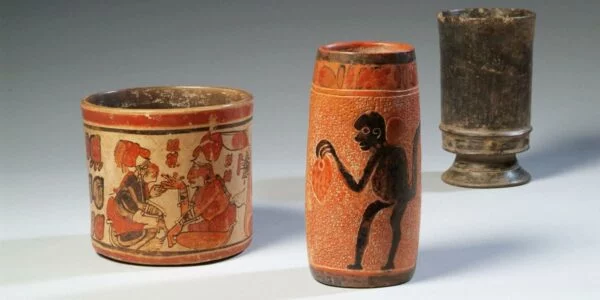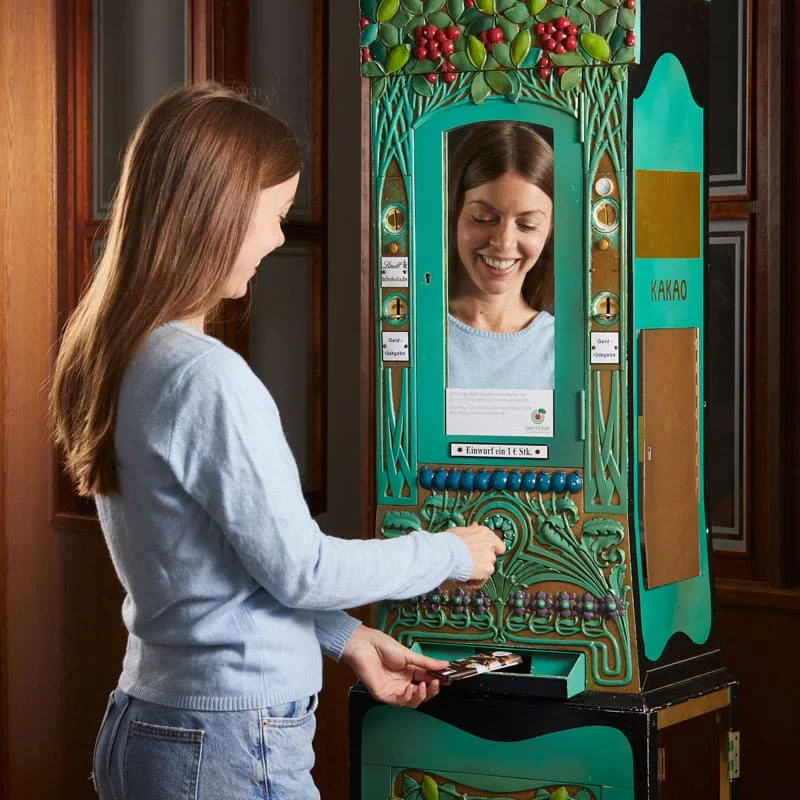
Our collection
We provide insights
The Chocolate Museum takes you on a journey through the 5000-year cultural history of chocolate. The most comprehensive presentation of the history and present of cocoa and chocolate in the world can be found on over 4,000 m².
We have brought together a wide variety of exhibits on the origins, history and cultural history of chocolate from all over the world. In total, our unique collection comprises around 2500 objects.

The conquerors and cocoa
Christopher Columbus was probably the first European to encounter cocoa in 1502, although he paid no further attention to it. At the end of the 16th century, chocolate became a popular drink among immigrant missionaries and settlers. From Mesoamerica, chocolate began its triumphal march around the world.

The treasure chamber
In the museum's "treasure chamber", you will gain an insight into pre-Columbian Mesoamerica, into the culture of the Olmecs, Maya and Aztecs, for whom cocoa, which also served as currency at times over the centuries, was a drink of the gods. Take a look at the extremely rare exhibits that illustrate the importance of cocoa to these peoples and how it was prepared. We show you sculptures and objects that were used in ritual acts as well as grating stones and drinking vessels.

How chocolate conquered Europe
The enjoyment of chocolate has a tradition dating back almost 5000 years. As a hot chocolate drink, cocoa conquered the elegant salons of the nobility and wealthy bourgeoisie in the 17th and 18th centuries. In the 18th century, chocolate was always prepared in the same way, the only difference being the taste due to the use of spices. The ingredients had to be of the highest quality. The preparation of chocolate was the responsibility of favorite maids and specially trained chocolate girls. Their only task was to ensure that the precious cocoa beans were processed into a drink and served.

The porcelain castle
You can admire valuable chocolate services in our porcelain castle. They illustrate the former importance of the luxury drink. Chocolate services made of the precious materials porcelain, silver or gold were required for the proper enjoyment of chocolate. Our collection shows you chocolate cups and pots that bear witness to the feudal use of this luxury product at court. Feel yourself transported back to the time of aristocratic society, whose life was characterized by cultivated idleness.
Fascinating cultural history
You can find out more about the development of chocolate into a luxury treat for everyone in our cultural history section. In the 19th and 20th centuries, chocolate slowly became more affordable as a result of industrialization and colonization. Nevertheless, cocoa and chocolates remained a gift for special occasions.
Whether on the radio or television, chocolate is omnipresent. Even in the past, the chocolate market spared no effort to impress us with beautiful packaging, enamel signs or posters. You can admire a wide variety of advertising materials in our exhibition, which were mainly used between the turn of the century and the 1950s. A luxury item becomes affordable.


Early advertising boom
Two historical store fittings show how elaborately decorated packaging for cocoa and chocolate products was presented in the past. You can find out more about the development of chocolate into a treat for everyone in our cultural history section.
In 1887, a groundbreaking attraction was invented: the chocolate vending machine. You can admire one of these historic machines in our collection and operate it - just like 100 years ago.
A look back at the early history of advertising and sales promotion is provided by the 30 or so magnificent chocolate vending machines in our collection, which could be found at the end of the 19th century in train stations in New York, on the Zugspitze or on the Champs-Elysées. Who doesn't remember the time of the unforgettable collector's pictures, which could be kept in specially made albums. Initially intended as an advertising medium for sample packs, they were soon so successful that they were used as a fully-fledged form of sales.
